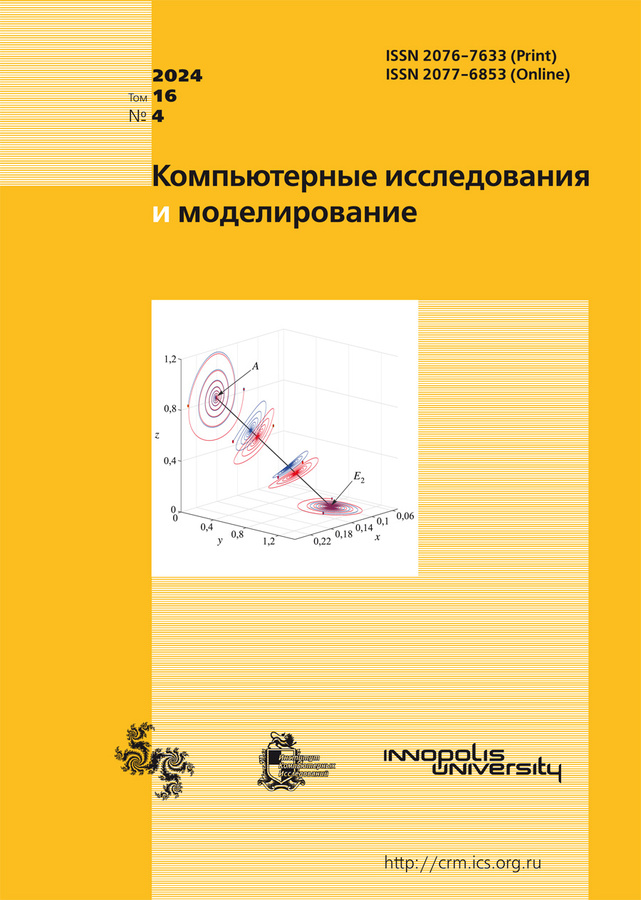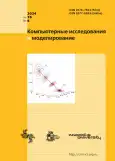Оптимизация стратегии геометрического анализа в автоматизированных системах проектирования
- Авторы: Божко А.Н.1, Ливанцов В.Э.1
-
Учреждения:
- Московский государственный технический университет имени Н. Э. Баумана
- Выпуск: Том 16, № 4 (2024)
- Страницы: 825-840
- Раздел: МАТЕМАТИЧЕСКИЕ ОСНОВЫ И ЧИСЛЕННЫЕ МЕТОДЫ МОДЕЛИРОВАНИЯ
- URL: https://bakhtiniada.ru/2076-7633/article/view/306589
- DOI: https://doi.org/10.20537/2076-7633-2024-16-4-825-840
- ID: 306589
Цитировать
Полный текст
Аннотация
Автоматизация проектирования процессов сборки сложных изделий — это важная и сложная научно-техническая проблема. Последовательность сборки и содержание сборочных операций в значительной степени зависят от механической структуры и геометрических свойств изделия. Приведен обзор методов геометрического моделирования, которые применяются в современных системах автоматизированного проектирования. Моделирование геометрических препятствий при сборке методами анализа столкновений, планирования перемещений и виртуальной реальности требует очень больших вычислительных ресурсов. Комбинаторные методы дают только слабые необходимые условия геометрической разрешимости. Рассматривается важная задача минимизации числа геометрических проверок при синтезе сборочных операций и процессов. Формализация этой задачи основана на гиперграфовой модели механической структуры изделия. Эта модель дает корректное математическое описание когерентных и секвенциальных сборочных операций, которые доминируют в современном дискретном производстве. Введено ключевое понятие геометрической ситуации. Это такая конфигурация деталей при сборке, которая требует проверки на свободу от препятствий, и эта проверка дает интерпретируемые результаты. Предложено математическое описание геометрической наследственности при сборке сложных изделий. Аксиомы наследственности позволяют распространить результаты проверки одной геометрической ситуации на множество других ситуаций. Задача минимизации числа геометрических тестов поставлена как неантагонистическая игра ЛПР и природы, в которой требуется окрасить вершины упорядоченного множества в два цвета. Вершины представляют собой геометрические ситуации, а цвет — это метафора результата проверки на свободу от коллизий. Ход ЛПР заключается в выборе неокрашенной вершины, ответ природы — это цвет вершины, который определяется по результатам моделирования данной геометрической ситуации. В игре требуется окрасить упорядоченное множество за минимальное число ходов. Обсуждается проектная ситуация, в которой ЛПР принимает решение в условиях риска. Предложен способ подсчета вероятностей окраски вершин упорядоченного множества. Описаны основные чистые стратегии рационального поведения в данной игре. Разработан оригинальный синтетический критерий принятия рациональных решений в условиях риска. Предложены две эвристики, которые можно использовать для окрашивания упорядоченных множеств большой мощности и сложной структуры.
Ключевые слова
Об авторах
Аркадий Николаевич Божко
Московский государственный технический университет имени Н. Э. Баумана
Автор, ответственный за переписку.
Email: bozh12@yandex.ru
Виктор Эдуардович Ливанцов
Московский государственный технический университет имени Н. Э. Баумана
Email: viktor.livantsov@yandex.ru
Список литературы
- А. Н. Божко, “Анализ геометрической разрешимости при сборке сложных изделий как задача принятия решений”, Математика и математическое моделирование, 2018, № 5, 17–34 [A. N. Bozhko, “Analysis of geometric reasoning in the assembly of complex products as a decision-making task”, Matematika i matematicheskoe modelirovanie, 2018, no. 5, 17–34 (in Russian)].
- А. Н. Божко, “Игровое моделирование геометрического доступа”, Наука и образование. МГТУ им. Н. Э. Баумана. Электрон. журн., 2009, № 12 https://cyberleninka.ru/article/n/igrovoe-modelirovanie-geometricheskogo-dostupa/viewer [A. N. Bozhko, “Game-theoretic modeling of geometric reasoning”, Nauka i obrazovanie. MGTU im. N. E. Baumana. Elektron. Journal, 2009, no. 12 https://cyberleninka.ru/article/n/igrovoe-modelirovanie-geometricheskogo-dostupa/viewer
- (in Russian)].
- А. Н. Божко, С. В. Родионов, “Комбинаторные методы геометрической разрешимости в автоматизированных системах проектирования. Обзор”, Информационные технологии, 28:3 (2022), 115–125 [A. Bozhko, S. Rodionov, “Combinatorial methods of geometric reasoning in computer-aided design systems. Review”, Informacionnye tekhnologii, 28:3 (2022), 115–125 (in Russian)].
- А. С. Рыков, Системный анализ: модели и методы принятия решений и поисковой оптимизации, Издательский дом МИСиС, М., 2009, 608 с. [A. S. Rykov, System analysis: models and methods of decision-making and search engine optimization, Izdatel’skij dom MISiS, Moscow, 2009, 608 pp. (in Russian)].
- A. N. Bozhko, “Hypergraph model for assembly sequence problem”, IOP Conference Series: Materials Science and Engineering, 560:1 (2019), 012010, IOP Publishing.
- A. N. Bozhko, “Mathematical modelling of mechanical structures and assembly processes of complex technical systems”, International Russian Automation Conference, 2021, 80–91.
- T.-H. Eng, Z.-K. Ling, W. Olson, Ch. Mclean, “Feature-based assembly modeling and sequence generation”, Computers & Industrial Engineering, 36:1 (1999), 17–33.
- S. Ghandi, E. Masehian, “Review and taxonomies of assembly and disassembly path planning problems and approaches”, Computer-Aided Design, 67–68 (2015), 58–86.
- D. González, et al., “A review of motion planning techniques for automated vehicles”, IEEE Transactions on Intelligent Transportation Systems, 17:4 (2015), 1135–1145.
- D. Halperin, J.-C. Latombe, R. H. A. Wilson, “General framework for assembly planning: the motion space approach”, Algorithmica, 26:3–4 (2000), 577–601.
- R. Hoffman, “A common sense approach to assembly sequence planning”, Computer-Aided Mechanical Assembly Planning, 148 (1991), 289–313.
- P. Jiménez, F. Thomas, C. Torras, “3D collision detection: a survey”, Computers & Graphics, 25:2 (2001), 269–285.
- S. Krishnan, A. Sanderson, “Reasoning about geometric constraints for assembly sequence planning”, Robotics and Automation, 1991. Proceedings, v. 1, 1991, 776–782.
- J. Miller, R. Hofman, “Automatic assembly planning with fasteners”, Robotics and Automation. Proceedings. 1989 IEEE International Conference, v. 1, 1989, 69–74.
- Ch. Pan, Sh. Smith, G. Smith, “Determining interference between parts in CAD STEP files for automatic assembly planning”, Journal of Computing and Information Science in Engineering, 5:1 (2005), 56–62.
- S. Roman, Lattices and ordered sets, Springer, 2008, 307 pp.
- B. Romney, C. Godard, M. Goldwasser, G. Ramkumar, “An efficient system for geometric assembly sequence generation and evaluation”, International Design Engineering Technical Conferences and Computers and Information in Engineering Conference, 1995, 699–712.
- M. Schenk, S. Straßburger, H. Kißner, “Combining virtual reality and assembly simulation for production planning and worker qualification”, Proc. of International Conference on Changeable, Agile, Reconfigurable and Virtual Production, 2005.
- A. Seth, J. M. Vance, J. H. Oliver, “Virtual reality for assembly methods prototyping: a review”, Virtual Reality, 15:1 (2011), 5–20.
- H. Srinivasan, R. Gadh, “A non-interfering selective disassembly sequence for components with geometric constraints”, IIE Transactions, 34:4 (2002), 349–361.
- Q. Su, “A hierarchical approach on assembly sequence planning and optimal sequences analyzing”, Robotics and Computer-Integrated Manufacturing, 25:1 (2009), 224–234.
- W. Weiwei, H. Kensuke, N. Kazuyuki, “Assembly sequence planning for motion planning”, Assembly Automation, 38:2 (2018), 195–206.
- R. Wilson, On geometric assembly planning, PhD thesis, Stanford Univ., Dept. Comput. Sci, Stanford, 1992, 156 pp.
- R. Wilson, J.-C. Latombe, “Geometric reasoning about mechanical assembly”, Artificial Intelligence, 71:2 (1994), 371–396.
- T. Woo, D. Dutta, “Automatic disassembly and total ordering in three dimension”, Journal of Engineering for Industry, 113:2 (1991), 207–213.
- Z. P. Yin, H. Ding, Y. L. Xiong, “A virtual prototyping approach to generation and evaluation of mechanical assembly sequences”, Proceedings of the Institution of Mechanical Engineers, Part B: Journal of Engineering Manufacture, 218:1 (2004), 87–102.
Дополнительные файлы










